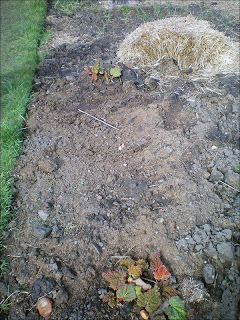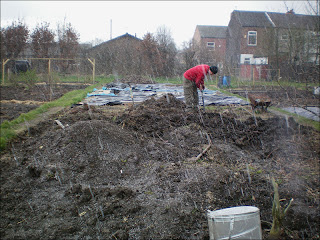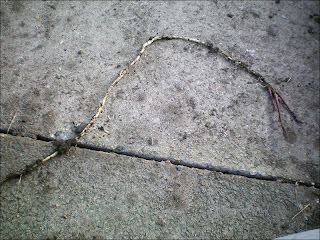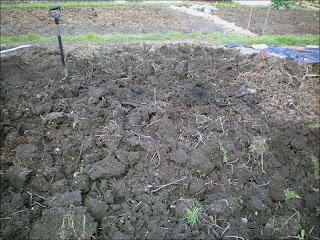In late summer 2007 we were offered a new plot, in addition to our half plot. This is the story of plot four...

Plot four had been standing derelict for around 4 years. The previous owner had used the plot to grow fruit; including apples, brambles and blackcurrants. As the plot had been left untended for so long, this is a long-term project. Plot four was a mass of brambles, bindweed and couch grass. About half the plot was approximately 6ft high in brambles and, hidden by bindweed, there were 4 apple trees in the area of the plot photographed.
The plan is to cultivate the full plot using a system of raised beds. The area to the right of this photograph is a large compost heap. This is 7ft tall, and although infested with perrenial weeds, should be an excellent source to fill our raised beds.
The compost heap fills half of the area which is normally used for a shed. Between this area and the main plot should be a path approximately 2 feet wide. As you can see from the photo the weeds have taken over the path!
Here is a 2nd photo showing the extent of brambles and bindweed on the top half of the plot.

Over the winter period we set on clearing plot four. During September we used glyphosphate to try and get a hold on the couch and bindweed problem. Although this is not ideal, plot four was in such a bad state that this seemed the best solution to help us get the area under control.
Here you can see the whole of plot four, taken from the bottom end in September, before the glyphosphate spraying. The bottom half of the plot did not have many brambles. but still had a problem with with bindweed and couch grass.

After spraying we purchased a bulk lot of black plastic and used this to cover about half of the plot. You can see the effect of the glyphosphate on the top growth of the weeds. This photo was taken in late October 2007.

During November we began clearing the top third of the plot. We used a mattock to dig out the bramble roots and by hand worked to remove the perenial weed roots.

The extent of the bindweed problem was quite daunting. We were, on average, filling this basket out of an area of 1 metre square.

We have now, in March 2008, nearly cleared the top 1/3 of plot four. The image below shows the same area as the first photo in this post! This area will be used for the greenhouse and 4 raised beds.

We have started to level the path which will be made from 3x2ft flags.


The raised beds for this area are 6x3ft and made from decking.





 The aubergine seeds germinated within 1 week sowing and are growing well. We will be growing these in a greenhouse to be situated on plot four.
The aubergine seeds germinated within 1 week sowing and are growing well. We will be growing these in a greenhouse to be situated on plot four.





















